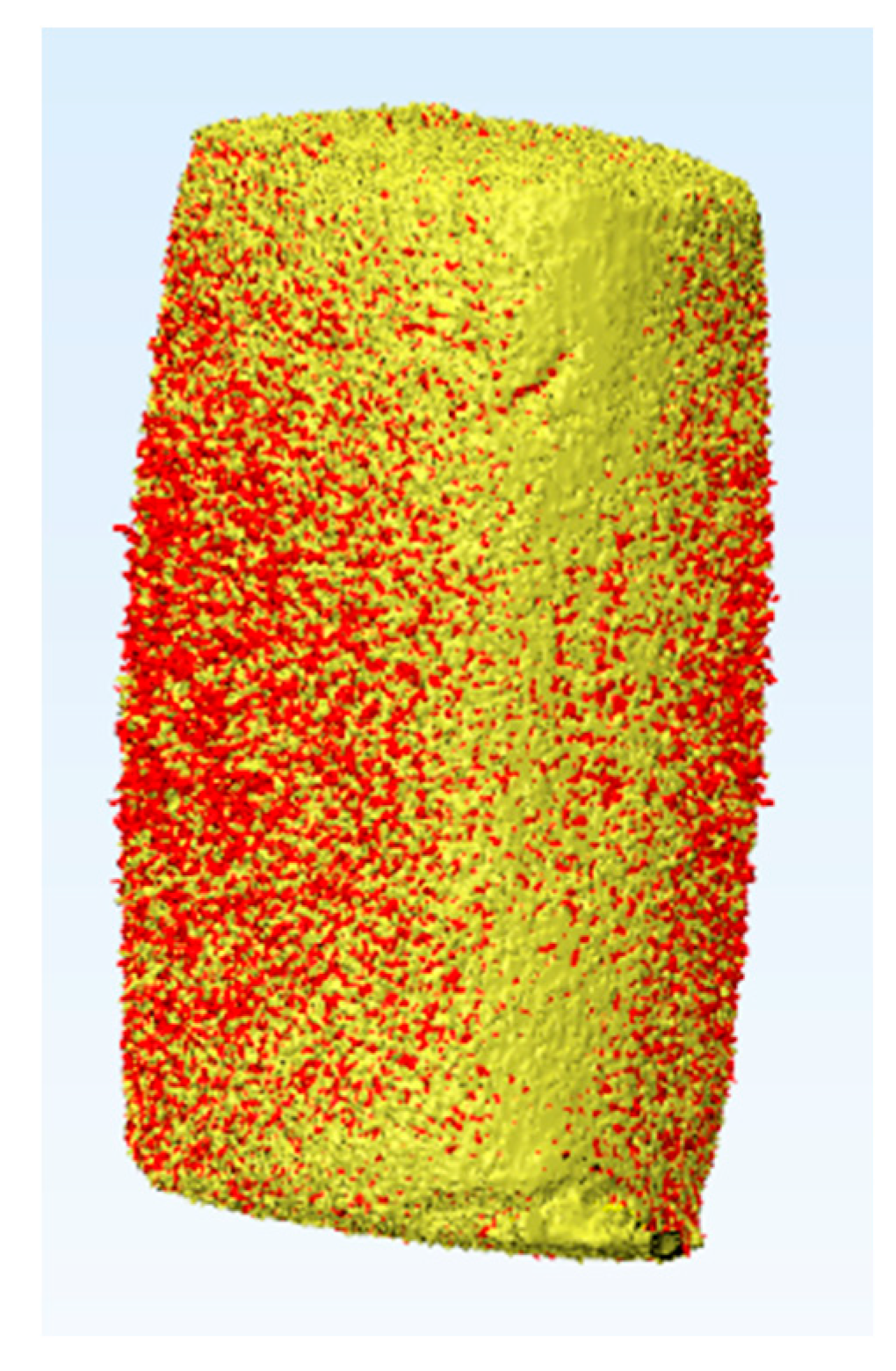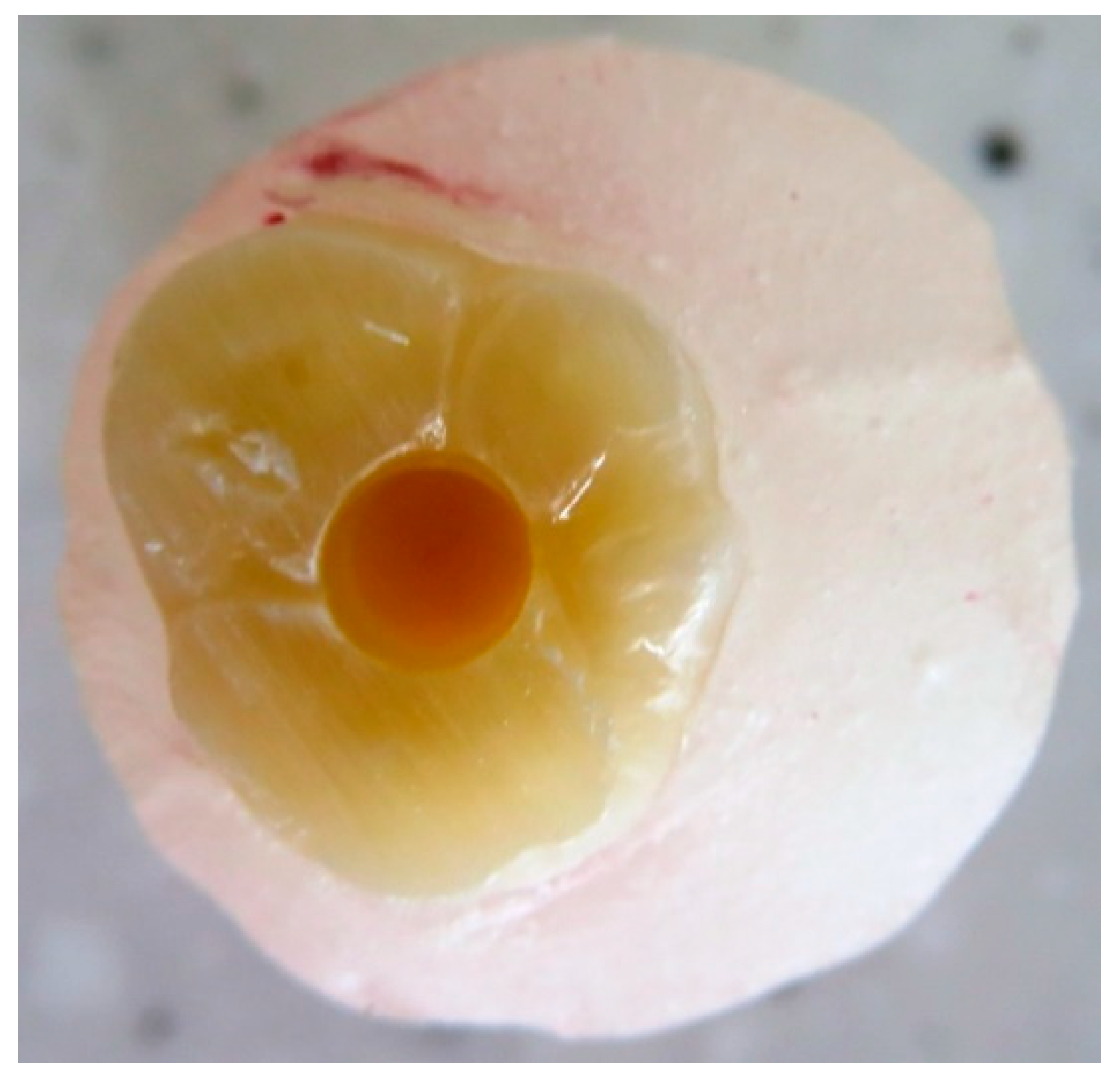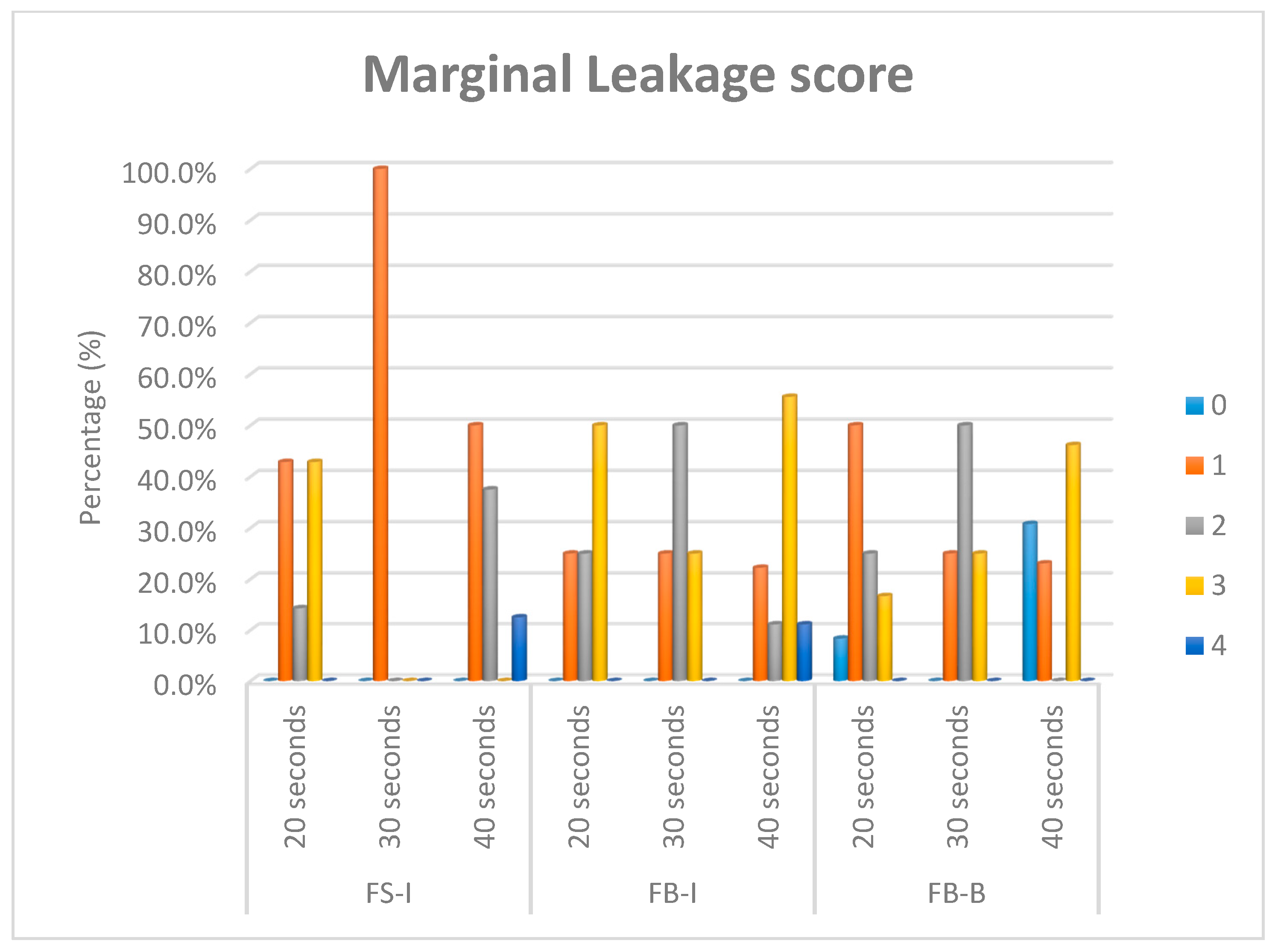Evaluation of Two Resin Composites Having Different Matrix Compositions
Abstract
1. Introduction
2. Materials and Methods
2.1. Materials
2.2. Methods
2.2.1. Depth of Cure (DoC)
2.2.2. Polymerization Shrinkage
2.2.3. Marginal Leakage
- ❖
- 0 = No dye penetration.
- ❖
- 1 = Dye penetration is only along enamel and does not pass the dentino–enamel junction (DEJ).
- ❖
- 2 = Penetration of the dye beyond the dentino–enamel junction but not reaching the pulpal floor.
- ❖
- 3 = Penetration of the dye to the pulpal floor.
- ❖
- 4 = Penetration of the dye to the pulp horn.
2.2.4. Statistical Analysis
3. Results
4. Discussion
5. Conclusions
Author Contributions
Funding
Acknowledgments
Conflicts of Interest
Abbreviations
References
- Truffier-Boutry, D. A physico-chemical explanation of the post-polymerization shrinkage in dental resins. Dent. Mater. 2006, 22, 405–412. [Google Scholar] [CrossRef] [PubMed]
- Van Dijken, J.W.V.; Pallesen, U. A randomized controlled three year evaluation of bulk-filled posterior resin restorations based on stress decreasing resin technology. Dent. Mater. 2014, 30, e245–e251. [Google Scholar] [CrossRef] [PubMed]
- Campos, E.A.; Ardu, S.; Lefever, D.; Jassé, F.F.; Bortolotto, T.; Krejci, I. Marginal adaptation of class II cavities restored with bulk-fill composites. J. Dent. 2014, 42, 575–581. [Google Scholar] [CrossRef]
- Stavridakis, M.M.; Kakaboura, A.I.; Ardu, S.; Krejci, I. Marginal and internal adaptation of bulk-filled Class I and Cuspal coverage direct resin composite restorations. Oper. Dent. 2007, 32, 515–523. [Google Scholar] [CrossRef] [PubMed]
- Hickey, D.; Sharif, O.; Janjua, F.; Brunton, P.A. Bulk dentine replacement versus incrementally placed resin composite: A randomised controlled clinical trial. J. Dent. 2016, 46, 18–22. [Google Scholar] [CrossRef] [PubMed]
- Zorzin, J. Bulk-fill resin composites: Polymerization properties and extended light curing. Dent. Mater. 2015, 31, 293–301. [Google Scholar] [CrossRef]
- Halvorson, R.H.; Erickson, R.L.; Davidson, C.L. Energy dependent polymerization of resin-based composite. Dent. Mater. 2002, 18, 463–469. [Google Scholar] [CrossRef]
- Ilie, N.; Bucuta, S.; Draenert, M. Bulk-fill resin-based composites: An in vitro assessment of their mechanical performance. Oper. Dent. 2013, 38, 618–625. [Google Scholar] [CrossRef]
- Garcia, A.H.; Lozano, M.A.M.; Vila, J.C.; Escribano, A.B.; Galve, P.F. Composite resins. A review of the materials and clinical indications. Med. Oral. Patol. Oral Cir. Bucal. 2006, 11, 215–220. [Google Scholar]
- Miranda, D.d.A. Effect of light curing tip distance and immersion media on the degree of conversion, sorption and solubility of methacrylate and silorane based composites. JSM Dent. 2013, 1, 1013. [Google Scholar]
- Cramer, N.B.; Stansbury, J.W.; Bowman, C.N. Recent advances and developments in composite dental restorative materials. J. Dent. Res. 2011, 90, 402–416. [Google Scholar] [CrossRef] [PubMed]
- Frauscher, K.E.; Ilie, N. Depth of cure and mechanical properties of nano-hybrid resin-based composites with novel and conventional matrix formulation. Clin. Oral Investig. 2012, 16, 1425–1434. [Google Scholar] [CrossRef]
- Kloxin, C.J.; Bowman, C.N. Covalent adaptable networks: Smart, reconfigurable and responsive network systems. Chem. Soc. Rev. 2013, 42, 7161–7173. [Google Scholar] [CrossRef] [PubMed]
- Bowman, C.N.; Kloxin, C.J. Covalent adaptable networks: Reversible bond structures incorporated in polymer networks. Angew. Chemie Int. Ed. 2012, 51, 4272–4274. [Google Scholar] [CrossRef] [PubMed]
- Furness, A.; Tadros, M.Y.; Looney, S.W.; Rueggeberg, F.A. Effect of bulk/incremental fill on internal gap formation of bulk-fill composites. J. Dent. 2014, 42, 439–449. [Google Scholar] [CrossRef]
- Asmussen, E. Factors affecting the quantity of remaining double bonds in restorative resin polymers. Eur. J. Oral Sci. 1982, 90, 490–496. [Google Scholar] [CrossRef]
- Flury, S.; Hayoz, S.; Peutzfeldt, A.; Hüsler, J.; Lussi, A. Depth of cure of resin composites: Is the ISO 4049 method suitable for bulk fill materials? Dent. Mater. 2012, 28, 521–528. [Google Scholar] [CrossRef]
- Kaisarly, D.; el Gezawi, M. Polymerization shrinkage assessment of dental resin composites: A literature review. Odontology 2016, 104, 257–270. [Google Scholar] [CrossRef]
- Kamalak, H.; Kamalak, A. Evaluation of polymerization shrinkage of dental composites by microcomputed tomography. Biomed. Res. 2018, 29, 844–852. [Google Scholar] [CrossRef]
- Wagner, D.W.; Lindsey, D.P.; Beaupre, G.S. Deriving tissue density and elastic modulus from microCT bone scans. Bone 2011, 49, 931–938. [Google Scholar] [CrossRef]
- Zou, W.; Gao, J.; Jones, A.S.; Hunter, N.; Swain, M.V. Characterization of a novel calibration method for mineral density determination of dentine by X-ray micro-tomography. Analyst 2009, 134, 72–79. [Google Scholar] [CrossRef] [PubMed]
- Cho, E.; Sadr, A.; Inai, N.; Tagami, J. Evaluation of resin composite polymerization by three dimensional micro-CT imaging and nanoindentation. Dent. Mater. 2011, 27, 1070–1078. [Google Scholar] [CrossRef] [PubMed]
- Sampaio, C.S. Microcomputed tomography evaluation of polymerization shrinkage of class I flowable resin composite restorations. Oper. Dent. 2017, 42, E16–E23. [Google Scholar] [CrossRef] [PubMed]
- Van Meerbeek, B. Adhesion to enamel and dentin: Current status and future challenges. Oper. Dent. 2003, 28, 215–235. [Google Scholar]
- Alani, A.H.; Toh, C.G. Detection of microleakage around dental restorations: A review. Oper. Dent. 1997, 22, 173–185. [Google Scholar] [PubMed]
- Gale, M.S.; Darvell, B.W. Thermal cycling procedures for laboratory testing of dental restorations. J. Dent. 1999, 27, 89–99. [Google Scholar] [CrossRef]
- Lima, R.B.W.; Murillo-Gómez, F.; Sartori, C.G.; de Goes, M.F. Bulk-fill resin composites: Mechanical properties vs depth of cure. Dent. Mater. 2016, 32, e20–e21. [Google Scholar] [CrossRef]
- Orlowski, M.; Tarczydlo, B.; Chalas, R.; Renata, C. Evaluation of marginal integrity of four bulk-fill dental composite materials: In vitro study. Sci. World J. 2015, 2015, 701262. [Google Scholar] [CrossRef]
- Leprince, J.G.; Leveque, P.; Nysten, B.; Gallez, B.; Devaux, J.; Leloup, G. New insight into the depth of cure of dimethacrylate-based dental composites. Dent. Mater. 2012, 28, 512–520. [Google Scholar] [CrossRef]
- Johnston, W.M.; Leung, R.L.; Fan, P.L. A mathematical model for post-irradiation hardening of photoactivated composite resins. Dent. Mater. 1985, 1, 191–194. [Google Scholar] [CrossRef]
- Bouschlicher, M.R.; Rueggeberg, F.A.; Wilson, B.M. Correlation of bottom-to-top surface microhardness and conversion ratios for a variety of resin composite compositions. Oper Dent. 2014, 29, 698–704. [Google Scholar]
- Santos, G.B.; Medeiros, I.S.; Fellows, C.E.; Muench, A.; Braga, R.R. Composite depth of cure obtained with QTH and LED units assessed by microhardness and micro-Raman spectroscopy. Oper. Dent. 2007, 32, 79–83. [Google Scholar] [CrossRef] [PubMed][Green Version]
- Price, R.B.T.; Labrie, D.; Rueggeberg, F.A.; Sullivan, B.; Kostylev, I.; Fahey, J. Correlation between the beam profile from a curing light and the microhardness of four resins. Dent. Mater. 2014, 30, 1345–1357. [Google Scholar] [CrossRef] [PubMed]
- Alrahlah, A.; Silikas, N.; Watts, D.C. Post-cure depth of cure of bulk fill dental resin-composites. Dent. Mater. 2014, 30, 149–154. [Google Scholar] [CrossRef]
- Strnad, G.; Jakab-Farkas, L. Improving the accuracy of low-load Vickers microhardness testing of hard thin films. Procedia Technol. 2014, 12, 289–294. [Google Scholar] [CrossRef]
- Chuenarrom, C.; Benjakul, P.; Daosodsai, P. Effect of indentation load and time on knoop and vickers microhardness tests for enamel and dentin. Mater. Res. 2009, 12, 473–476. [Google Scholar] [CrossRef]
- Voort, G.F.V.; Lucas, G.M. Microindentation hardness testing. Adv. Mater. Process. 1998, 154, 21–24. [Google Scholar]
- Alshali, R.Z.; Salim, N.A.; Satterthwaite, J.D.; Silikas, N. Post-irradiation hardness development, chemical softening, and thermal stability of bulk-fill and conventional resin-composites. J. Dent. 2015, 43, 209–218. [Google Scholar] [CrossRef]
- Ilie, N.; Stark, K. Curing behaviour of high-viscosity bulk-fill composites. J. Dent. 2014, 42, 977–985. [Google Scholar] [CrossRef] [PubMed]
- Lempel, E. Degree of conversion and BisGMA, TEGDMA, UDMA elution from flowable bulk fill composites. Int. J. Mol. Sci. 2016, 17, 732. [Google Scholar] [CrossRef]
- Atai, M.; Ahmadi, M.; Babanzadeh, S.; Watts, D.C. Synthesis, characterization, shrinkage and curing kinetics of a new low-shrinkage urethane dimethacrylate monomer for dental applications. Dent. Mater. 2007, 23, 1030–1041. [Google Scholar] [CrossRef] [PubMed]
- Kerby, R.E.; Knobloch, L.A.; Schricker, S.; Gregg, B. Synthesis and evaluation of modified urethane dimethacrylate resins with reduced water sorption and solubility. Dent. Mater. 2009, 25, 302–313. [Google Scholar] [CrossRef] [PubMed]
- Stansbury, J.W. Synthesis and evaluation of novel multifunctional oligomers for dentistry. J. Dent. Res. 1992, 71, 434–437. [Google Scholar] [CrossRef] [PubMed]
- Deb, S.; di Silvio, L.; Mackler, H.E.; Millar, B.J. Pre-warming of dental composites. Dent. Mater. 2011, 27, e51–e59. [Google Scholar] [CrossRef]
- Junior, A. Is there correlation between polymerization shrinkage, gap formation, and void in bulk fill composites? A μCT study. Braz. Oral Res. 2017, 31, e100. [Google Scholar] [CrossRef][Green Version]
- Kim, R.J.-Y.; Kim, Y.-J.; Choi, N.-S.; Lee, I.-B. Polymerization shrinkage, modulus, and shrinkage stress related to tooth-restoration interfacial debonding in bulk-fill composites. J. Dent. 2015, 43, 430–439. [Google Scholar] [CrossRef]
- El-Damanhoury, H.M.; Platt, J.A. Polymerization shrinkage stress kinetics and related properties of bulk-fill resin composites. Oper. Dent. 2014, 39, 374–382. [Google Scholar] [CrossRef]
- Hilton, T.J. Can modern restorative procedures and materials reliably seal cavities? In vitro investigations. Part 2. Am. J. Dent. 2002, 15, 279–289. [Google Scholar] [PubMed]
- Gwinnett, J.A.; Tay, F.R.; Pang, K.M.; Wei, S.H.Y. Comparison of three methods of critical evaluation of microleakage along restorative interfaces. J. Prosthet. Dent. 1995, 74, 575–585. [Google Scholar] [CrossRef]
- Retief, D.H.; Woods, E.; Jamison, H.C. Effect of cavosurface treatment on marginal leakage in class V composite resin restorations. J. Prosthet. Dent. 1982, 47, 496–501. [Google Scholar] [CrossRef]
- Manojlovic, D.; Radisic, M.; Vasiljevic, T.; Zivkovic, S.; Lausevic, M.; Miletic, V. Monomer elution from nanohybrid and ormocer-based composites cured with different light sources. Dent. Mater. 2011, 27, 371–378. [Google Scholar] [CrossRef] [PubMed]
- Ilie, N.; Schöner, C.; Bücher, K.; Hickel, R. An in-vitro assessment of the shear bond strength of bulk-fill resin composites to permanent and deciduous teeth. J. Dent. 2014, 42, 850–855. [Google Scholar] [CrossRef]
- Inoue, S. Microtensile bond strength of eleven contemporary adhesives to dentin. J. Adhes. Dent. 2001, 3, 237–245. [Google Scholar] [PubMed]
- Van Meerbeek, B. Clinical status of ten dentin adhesive systems. J. Dent. Res. 1994, 73, 1690–1702. [Google Scholar] [CrossRef]
- Ferracane, J.L. Developing a more complete understanding of stresses produced in dental composites during polymerization. Dent. Mater. 2005, 21, 36–42. [Google Scholar] [CrossRef] [PubMed]
- Braga, R.R.; Ballester, R.Y.; Ferracane, J.L. Factors involved in the development of polymerization shrinkage stress in resin-composites: A systematic review. Dent. Mater. 2005, 21, 962–970. [Google Scholar] [CrossRef]
- Almeida, J.B.; Platt, J.A.; Oshida, Y.; Moore, B.K.; Cochran, M.A.; Eckert, G.J. Three different methods to evaluate microleakage of packable composites in Class II restorations. Oper. Dent. 2003, 28, 453–460. [Google Scholar]





| Material | Lot No. | Composition 1 |
|---|---|---|
| Filtek Bulk Fill posterior restorative Shade: A2 | N701975 | Fillers: non-agglomerated nanosilica of 20 nm filler size and agglomerated zirconia/silica nanocluster with a size of 5–20 nm. The filler loading was 76.5 wt% (58.5% by volume). Organic matrix: Bisphenol-A glycidyl dimethacrylate (Bis-GMA) (1–10 wt%), urethane dimethacrylate (UDMA) (10–20 wt%), triethylene glycol dimethacrylate (TEGDMA) (<1 wt%), bisphenol A polyethylene glycol diether dimethacrylate (Bis-EMA)-6 (1–10 wt%), in addition to addition–fragmentation monomer (AFM), aromatic urethane dimethacrylate (AUDMA), and 1,12-dodecane dimethacrylate (DDDMA). |
| Filtek Supreme XTE Universal Shade: A2 body | N862133 | Fillers: non-agglomerated nanosilica of 20 nm filler size and agglomerated zirconia/silica nanocluster with the size of 5–20 nm. The filler loading was 78.5 wt% (63.3% by volume). Organic matrix: Bis-GMA (5–10 wt%), UDMA (5–10 wt%), TEGDMA (5–10 wt%), Bis-EMA6 (1–10%), and polyethylene glycol dimethacrylate (PEGDMA) resins. |
| Packing Techniques | Curing Time (Means ±SD) | p-Value | ||
|---|---|---|---|---|
| 20 s | 30 s | 40 s | ||
| Filtek Supreme-Incremental (FS-I) | 0.99 ± 0.17 Aa | 0.96 ± 0.01 Ba | 0.94 ± 0.02 Ba | 0.002 * |
| Filtek Bulk-Incremental (FB-I) | 0.97 ± 0.04 Aa | 0.96 ± 0.02 Aa | 0.98 ± 0.03 Aa | 0.676 ns |
| Filtek Bulk-Bulk (FB-B) | 0.90 ± 0.02 Bb | 0.99 ± 0.04 Aa | 0.98 ± 0.03 ABa | 0.003 * |
| p-value | <0.001 * | 0.054 ns | 0.111 ns | |
| Packing Technique | Curing Time | Mean | St. Deviation |
|---|---|---|---|
| Filtek Supreme-Incremental (FS-I) | 20 s | −1.9% | 0.2 |
| 30 s | −2.0% | 0.3 | |
| 40 s | −1.9% | 0.3 | |
| Filtek Bulk-Incremental (FB-I) | 20 s | −1.6% | 0.3 |
| 30 s | −1.7% | 0.4 | |
| 40 s | −1.7% | 0.4 | |
| Filtek Bulk-Bulk (FB-B) | 20 s | −1.4% | 0.3 |
| 30 s | −1.5% | 0.3 | |
| 40 s | −1.5% | 0.4 |
| Packing Technique | Curing Time | p-Value | ||
|---|---|---|---|---|
| 20 s | 30 s | 40 s | ||
| Filtek Supreme-Incremental (FS-I) | 2.0 (2.0) | 1.0 (0.0) | 1.6 (3.0) | 0.72 ns |
| Filtek Bulk Fill-Incremental (FB-I) | 2.3 (2.0) | 2.0 (2.0) | 2.7 (3.0) | 0.84 ns |
| Filtek Bulk Fill-Bulk (FB-B) | 1.4 (3.0) | 2.0 (2.0) | 1.4 (3.0) | 0.82 ns |
| p-value | 0.21 ns | 0.05 * | 0.19 ns | |
© 2020 by the authors. Licensee MDPI, Basel, Switzerland. This article is an open access article distributed under the terms and conditions of the Creative Commons Attribution (CC BY) license (http://creativecommons.org/licenses/by/4.0/).
Share and Cite
Elshazly, T.M.; Bourauel, C.; Sherief, D.I.; El-Korashy, D.I. Evaluation of Two Resin Composites Having Different Matrix Compositions. Dent. J. 2020, 8, 76. https://doi.org/10.3390/dj8030076
Elshazly TM, Bourauel C, Sherief DI, El-Korashy DI. Evaluation of Two Resin Composites Having Different Matrix Compositions. Dentistry Journal. 2020; 8(3):76. https://doi.org/10.3390/dj8030076
Chicago/Turabian StyleElshazly, Tarek M., Christoph Bourauel, Dalia I. Sherief, and Dalia I. El-Korashy. 2020. "Evaluation of Two Resin Composites Having Different Matrix Compositions" Dentistry Journal 8, no. 3: 76. https://doi.org/10.3390/dj8030076
APA StyleElshazly, T. M., Bourauel, C., Sherief, D. I., & El-Korashy, D. I. (2020). Evaluation of Two Resin Composites Having Different Matrix Compositions. Dentistry Journal, 8(3), 76. https://doi.org/10.3390/dj8030076






